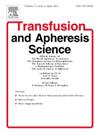A serological and molecular study on a case of Rh blood group mosaicism
IF 1.4
4区 医学
Q4 HEMATOLOGY
引用次数: 0
Abstract
Background
Mosaicism refers to the presence of two or more genetically different cell lines within a single individual, the majority of which are accidentally discovered through routine blood group identification. Here, we report one case of Rh blood group mosaicism in a 10-year-old Chinese male.
Methods
Serological tests for the Rh blood group were performed via gel microcolumn tests and saline methods. Mosaic red blood cells (RBCs) were quantified via flow cytometry. The G-banded karyotype was analyzed at a 550-band resolution. Short tandem repeat (STR) analysis was used to compare the allele repeats at specific loci in DNA between blood, buccal mucosal, and hair shaft samples.
Results
Mixed-field agglutination with anti-C and anti-e antibodies was identified in the gel microcolumn test. The proportion of those positive for the C antigen was 47.26 %, while that of the negative ones was 52.74 %, as calculated by flow cytometry, and the double populations were identified as DCcEe- and DccEE-phenotype RBCs by multiple centrifugations. Karyotype analysis revealed 46, XY in the proband. STR analysis revealed that additional paternal alleles were present at the D1S1656, CSF1PO, and Penta D loci.
Conclusion
An individual with natural Rh blood group mosaicism was identified.
1例Rh血型嵌合的血清学和分子研究
镶嵌现象是指在单个个体中存在两种或两种以上基因不同的细胞系,其中大多数是通过常规血型鉴定偶然发现的。本文报告一例10岁中国男性Rh血型嵌合。方法采用凝胶微柱法和生理盐水法对Rh血型进行血清学检测。流式细胞术定量检测嵌合红细胞(rbc)。在550波段分辨率下分析g带核型。短串联重复序列(STR)分析用于比较血液、口腔黏膜和毛干样本中DNA特定位点的等位基因重复序列。结果凝胶微柱法检测到抗c抗体和抗e抗体混合场凝集。流式细胞术计算C抗原阳性的比例为47.26 %,阴性的比例为52.74 %,经多次离心鉴定为DCcEe-型和DCcEe-型红细胞。先证者核型分析显示为46,xy。STR分析显示,在D1S1656、CSF1PO和Penta D位点存在额外的父本等位基因。结论发现1例具有天然Rh血型嵌合的个体。
本文章由计算机程序翻译,如有差异,请以英文原文为准。
求助全文
约1分钟内获得全文
求助全文
来源期刊
CiteScore
3.60
自引率
5.30%
发文量
181
审稿时长
42 days
期刊介绍:
Transfusion and Apheresis Science brings comprehensive and up-to-date information to physicians and health care professionals involved in the rapidly changing fields of transfusion medicine, hemostasis and apheresis. The journal presents original articles relating to scientific and clinical studies in the areas of immunohematology, transfusion practice, bleeding and thrombotic disorders and both therapeutic and donor apheresis including hematopoietic stem cells. Topics covered include the collection and processing of blood, compatibility testing and guidelines for the use of blood products, as well as screening for and transmission of blood-borne diseases. All areas of apheresis - therapeutic and collection - are also addressed. We would like to specifically encourage allied health professionals in this area to submit manuscripts that relate to improved patient and donor care, technical aspects and educational issues.
Transfusion and Apheresis Science features a "Theme" section which includes, in each issue, a group of papers designed to review a specific topic of current importance in transfusion and hemostasis for the discussion of topical issues specific to apheresis and focuses on the operators'' viewpoint. Another section is "What''s Happening" which provides informal reporting of activities in the field. In addition, brief case reports and Letters to the Editor, as well as reviews of meetings and events of general interest, and a listing of recent patents make the journal a complete source of information for practitioners of transfusion, hemostasis and apheresis science. Immediate dissemination of important information is ensured by the commitment of Transfusion and Apheresis Science to rapid publication of both symposia and submitted papers.

 求助内容:
求助内容: 应助结果提醒方式:
应助结果提醒方式:


